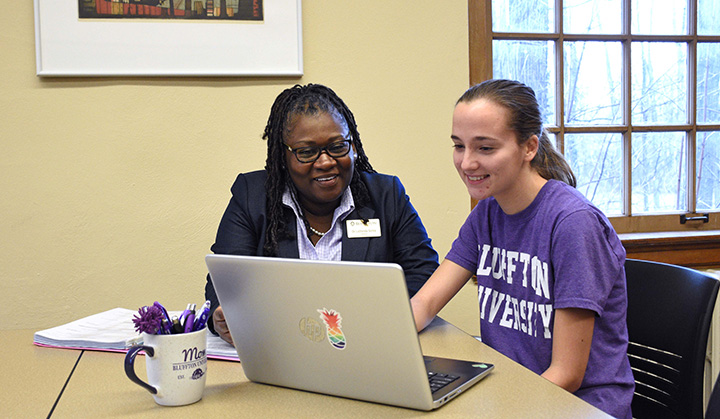Creating an ePortfolio in College Central

Growth is something that can be difficult to see. This is especially true when it is our own growth we seek to witness and describe. Imagine watching an infant grow into a toddler – then a child, an adolescent, an adult. The difference between any two days is imperceptible, but the difference over weeks, months, years and decades can be dramatic. Now imagine looking into a mirror every day and looking for changes in your own capacities. How much harder would such daily growth be to see?
ePortfolios are one way you can watch this growth.
Adapted from the Becoming a Scholar reader, 2018-19
College – tracking your academic work from your first semester through graduation; witnessing your own growth in how you understand, think, communicate, question and integrate learning across your academic journey.
Bluffton University ePortfolio Process
All students have an account in Bluffton University’s College Central Network (CCN). To access and update your account, follow the steps below.
| 1 | Go to https://www.collegecentral.com/bluffton/ (you can also get here through the Center for Career and Vocation page on Buffton’s website: https://www.bluffton.edu/academiclife/career/findjob/employlinks.aspx. Click on College Central and then the “Students” box at the bottom of the page. |
| 2 | Enter your 6-digit Student ID in the “User ID” field. If your ID is only 5-digits long, add a lead zero (for example, “34567” would be entered as “034567”). |
| 3 | The first time you enter, click on “Forgot your Password.” This will allow you to set up your account and enter a password of your choosing for future log-in. |
| 4 | Once you get to the CCN Dashboard, we encourage you to explore all of the CCN functions. Eventually, though, you will want to click on “My Career Portfolio” on the left side of the page. |
| 5 | Click on “Create a Career Portfolio.” On this page, you can read the one-page help document in the upper right hand corner. Then select the “General Career Portfolio” option from the list. If you are in art, design, theatre or music, you may want to return later in your program to consider a different format; for now, though, the General Career Portfolio offers the broadest options for uploading documents (doc/docx, pdf, ppt, etc.). |
| 6 | Click the green “Create” button to get started. |
| 7 | There are great help features on this page, including a video tutorial and pop-up tips accessed by hovering over the gray question marks. |
| 8 | Add the two required items listed in your Becoming a Scholar syllabus by clicking the “Add” button in any center section. You will give your posting a title and a brief description. Then click “Choose file” to locate the document on your computer and “Save” to add it to your ePortfolio. |
| 9 | Once you have added two items, additional buttons will appear at the top of the page.
These are settings that allow your ePortfolio to be located by employer searches and
to be shared by email with your professor or others. We recommended the following
settings for these buttons: Employer Search – leave set to “Off” (the default) Shareable Link – move to “On” so that you can share your ePortfolio with your professor if asked |
| 10 | On the right hand side of the page, you will see similar “Add” buttons to add languages, a website or blog, and a personal statement. |